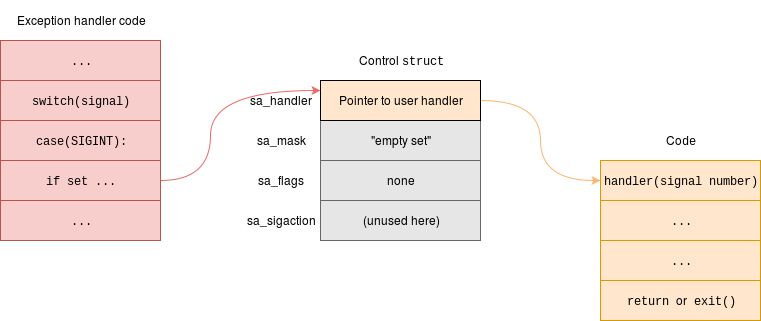Exercises:Exceptions: Difference between revisions
pc>Yuron No edit summary |
m 1 revision imported |
(No difference)
| |
Latest revision as of 10:22, 9 August 2019
| On path: Exercises | 0: Exercises • 1: Pointer Exercise • 2: Arguments Exercise • 3: Malloc Exercise • 4: Structs Exercise • 5: Processes Exercise • 6: Shared memory Exercise • 7: Pipes Exercise • 8: Exceptions Exercise • 9: Synchronisation Exercise • 10: Files Exercise • 11: Threads Exercise • 12: Unix proc Exercise |
|---|
| Depends on | Exceptions • Unix Signals |
|---|
The purposes of this exercise are:
- A first look at Unix exceptions: what they might do and how to intercept them
- To illustrate how, for example, interrupts work
This demonstration is primarily intended to illustrate what is possible with exceptions. This may not be completely ‘bulletproof’ code; before applying these principles in a ‘real’ application (at some future time), read (and understand!) some more background material.
The code also shows the sort of principle used by interrupts – i.e. the insertion of some ‘foreign’ code fragment at ‘random’ points during execution – with you as the interrupting device.
Part 1
- Compile and execute
sigint.cin a Unix shell. Note: this is set up to be compiled without optimisation. This is to prevent the compiler from spotting the code apparently does nothing and removing the increment.
This is about the most useless counting program possible; although it is incrementing a variable, it never outputs it and it never stops (of its own accord, at least).
- Press
^C(that’s Ctrl+C) in the shell to stop it. - Uncomment the statements from
/*to*/and repeat the process above.
The program is marginally more useful in that now you can see the value reached when it terminates, with a friendly little printout.
The statements which were added set up a data structure and then link that structure to a (predefined, in signal.h) signal 'SIGINT'; SIGINT is sent (for example) by the shell when you press ^C. The structure contains a pointer to the function goodbye(); this function is then executed in preference to the default action when a SIGINT occurs.
Here, the function then terminates the application.

Part 2
- Compile and execute
escape.c
The difference here is that, instead of ‘exit’ting the function (renamed escape()) ‘return’s to the loop.
After, perhaps, a moment of panic you should observe that persistence will pay off, and you can get out.
If that get-out clause were not there, there are other signals which have not been trapped here: you could still, for example, kill that process. It would be a good idea to know how to do this if you want to tinker further with this example.
This exercise also illustrates the principle of an ‘interrupt’. The body of your code (which could be doing more useful stuff) does its own thing but a function call can be invoked from the external ‘hardware’. (In this case the signal is sent by the O.S. software to the application rather than the hardware to the kernel as in an interrupt, but the effect is the same.)
In this case your frantic jabbing at the keyboard provided the ‘interrupts’. Usually in a ‘real’ (machine) interrupt the function is called an “Interrupt Service Routine” (“ISR”) and will do something with the appropriate hardware and then return. As is observable, the exact timing – hence the position in the code – of the interrupt is not predictable.
Part 3
- Compile and execute
segfault.cAs supplied this tries to follow aNULLpointer (*p) which should cause a segmentation fault. - Uncomment the statements from “
/*” to “*/” and repeat the process above. This has trapped a different exception:SIGSEGV.
These traps are not exclusive. The function broken() has a parameter which can be used to sort out what happened. A hint at how this might be done has been left in the code and you can play if you’re feeling keen.
Puzzle
Identify and intercept at least one more Unix signal. For example, you could combine this with your previous ‘processes’ code and signal from child to parent. There is some reference material below, which may help with ideas.
Reference material
- Unix signals and traps (tutorialspoint)
- Unix signals and traps (Wikipedia)
- Difference between signals and interrupts